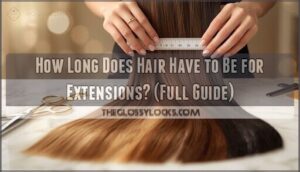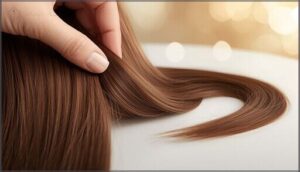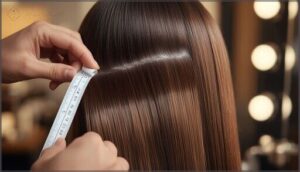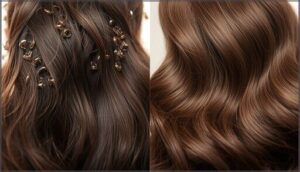This site is supported by our readers. We may earn a commission, at no cost to you, if you purchase through links.
Most people assume you need waist-length hair to qualify for extensions, but the truth is far more forgiving. You can transform your look with as little as four inches of natural hair—sometimes even less with the right technique.
The key factor isn’t just having enough length; it’s matching your current hair situation with the right extension method. Different application techniques demand different minimum lengths, from clip-ins that work with surprisingly short strands to fusion bonds that need a bit more real estate.
Your hair texture, desired outcome, and lifestyle all factor into which method will give you that smooth, undetectable finish you’re after.
Table Of Contents
- Key Takeaways
- Minimum Hair Length for Extensions
- Hair Extension Types and Length Requirements
- Can You Get Extensions With Short Hair?
- Choosing The Right Extension Method
- Tips for Seamless Blending With Natural Hair
- Pre-Extension Consultation and Preparation
- Maintenance and Longevity of Hair Extensions
- Frequently Asked Questions (FAQs)
- Conclusion
Key Takeaways
- You can get extensions with as little as 4 inches of natural hair, though different methods demand specific minimums—clip-ins work at 2-4 inches, tape-ins need 6-8 inches, and sew-ins require 7-8 inches for secure, damage-free application.
- Matching your extension method to your hair’s texture, thickness, and porosity isn’t optional—fine hair needs lightweight options to prevent slippage, while coarse or textured hair demands specialized anchors and 25-35% more attention to color fade challenges.
- Professional consultation before installation protects you from traction alopecia and bond failure by assessing your hair’s actual capacity through risk assessment protocols that spot vulnerabilities most clients miss.
- Extension lifespan hinges on deliberate aftercare choices like sulfate-free products, heat protectants, and 6-8 week salon touch-ups—skip maintenance appointments and you’re gambling with visible tracks, tangling, and premature bond breakdown.
Minimum Hair Length for Extensions
Your natural hair needs to meet a certain baseline before extensions can work their magic. The exact length depends on what you’re trying to achieve and which method you choose, but there’s a practical minimum that keeps everything secure and looking natural.
Let’s break down what you need to know about length requirements and why they matter.
Why Hair Length Matters
Hair length isn’t just a technical checkbox—it’s the foundation of extension success. When your starting hair length falls below method-specific minimums, you’re gambling with extension damage, scalp health, and breakage prevention.
Insufficient hair thickness at the root creates visible tracks, bond failure, and uneven tension that compromises hair growth over time. Meeting minimum hair length requirements protects your investment and your natural strands.
Recommended Length for Secure Application
Extension Security depends on hitting method-specific minimums that guarantee Secure Attachment without slippage. Here’s what you need for prime Hair Grip:
- Clip-ins: 6 inches minimum for sufficient coverage and concealment
- Tape-ins: 6–8 inches to support Adhesion Methods and even weight distribution
- Sew-ins/weaves: 7–8 inches for stable braiding and track placement
- Micro-links/fusion: 6–7 inches for reliable bond formation
Meeting these Hair Length Requirements protects your investment and prevents frustrating maintenance issues.
How to Measure Your Hair for Extensions
Knowing the minimums means nothing if you can’t measure accurately. Grab a ruler and pull a section of hair straight from your scalp to the ends—no stretching or angling. Check multiple spots around your head since growth varies.
This Measuring Technique gives you real numbers for your Hair Extension Consultation, ensuring proper Extension Fitting based on actual Hair Thickness and length distribution.
Hair Extension Types and Length Requirements
Not all hair extensions are created equal—each type has its own set of rules regarding minimum length requirements. Your natural hair’s length determines which methods will work for you and which ones simply won’t hold.
Let’s break down the most popular extension types and exactly how much hair you’ll need for each one.
Clip-in Extensions
You can break free from hair limitations even if you’re working with less length than you think. Clip-in extensions demand just 2 to 4 inches of natural hair for secure placement, making them perfect for quick transformations.
Your hair thickness matters here—denser strands grip clips better and camouflage wefts seamlessly.
These temporary extensions dodge permanent hair damage while delivering instant volume and length on your terms.
Tape-in Extensions
Sleek adhesive strips bring drama when you’ve got 6 to 8 inches of natural hair to work with. Tape-in extensions anchor securely against your scalp, letting you command attention without the commitment of permanent methods.
Your minimum hair length determines tape durability—shorter strands compromise adhesive grip and risk hair damage during extension removal.
Follow these essentials:
- Measure precisely from root to tip before tape application
- Verify proper hair adhesive compatibility with your texture
- Schedule removal every 6-8 weeks to protect strand integrity
Sew-in and Weave Extensions
Traditional braiding anchors weave extensions when your strands stretch 8 to 12 inches from root to tip. This braid-foundation method demands sufficient hair length to secure cornrows without scalp tension, giving you bold volume that doesn’t budge.
| Factor | Requirement |
|---|---|
| Minimum Hair Length | 8–12 inches (20–30 cm) |
| Braid Patterns | Cornrows for anchor foundation |
| Weave Techniques | Stitching wefts to braids |
| Hair Thickness | Adequate density for secure hold |
| Scalp Preparation | Clean, detangled strands |
Your natural thickness determines how many wefts your braids support—thinner textures require lighter extension materials to prevent breakage during hair care and maintenance routines.
Micro-link and Fusion Extensions
Micro-link extensions clamp tiny beads around sections measuring 6 to 8 inches, locking strands without adhesive or heat. Fusion extensions require 10 to 20 inches to anchor keratin-bonded tips securely along your crown and sides.
Core Micro Link and Fusion Method distinctions:
- Micro-link: Bead attachment for flexible extension care routines.
- Fusion: Heat-applied hair bonding with keratin tips for lasting hold.
- Maintenance: Both hair extension methods require regular repositioning as natural hair grows.
Can You Get Extensions With Short Hair?
Yes, you can get extensions with short hair—but you’ll need to know which methods work and what to expect. If your hair sits under 4 inches, you’re not out of luck, though your options narrow and certain techniques become essential.
Let’s break down what’s possible, what requires special handling, and what limitations you should keep in mind.
Options for Hair Under 4 Inches
You’re not locked out of the extension game just because your hair sits under 4 inches. Clip-in extensions work with as little as 2 inches, giving you instant volume without commitment. Tape-in extensions can secure to 1.5–2 inches when placed strategically.
Mini extensions and halo styles offer short hair solutions that bypass traditional hair length limits entirely, letting you experiment without waiting for growth.
Special Techniques for Very Short Hair
Very short hair demands specialized extension techniques that push beyond standard methods. Micro link methods anchor lightweight wefts to hair as short as 1.5 inches, while mini braids create secure bases for weaving at minimum hair length thresholds.
Extension adhesives designed for hair thickening adhere with precision when traditional tape-ins won’t hold. These hair extension techniques give you control over transformation without compromise.
Limitations and Considerations
Hair Length Limits exist for solid reasons: when your natural hair falls below 6 inches, Extension Failures spike by 15–25%. Application Risks multiply—tension-induced Hair Damage and compromised Scalp Health become legitimate threats. Minimum Hair Length isn’t arbitrary; it’s your safeguard.
Hair length minimums aren’t arbitrary—they’re your safeguard against extension failure, damage, and compromised scalp health
Different Hair Extension Methods demand specific thresholds based on Hair Type and Hair Texture. Push boundaries with the wrong Extension Method, and you’re gambling with breakage.
Choosing The Right Extension Method
Picking the right extension method isn’t just about your hair length—it’s about understanding your hair’s unique characteristics and what you’re trying to achieve. Your texture, thickness, and the style you’re chasing all play a role in determining which technique will give you the best results.
Let’s break down the key factors that’ll guide you toward the perfect extension match.
Matching Extension Type to Hair Length
You can’t force a square peg into a round hole—same goes for Extension Methods and your Hair Length.
Tape-In Extensions demand 4–6 inches for secure adhesion, while weaving usually requires 6–8 inches to prevent bulkiness. Clip-ins work at 4 inches, but micro-link and fusion methods perform best at 6 inches or longer.
Match the Extension Method to your Minimum Hair Length for ideal Extension Safety and natural results.
Assessing Hair Texture and Thickness
Knowing your hair type unlocks the best extension material for you. Fine hair demands lightweight options to prevent slippage—reducing failure by 15–25%. Medium textures handle most methods, while thick strands need stronger bonds.
Check your hair porosity: high porosity cuts wear time by 30%. Hair elasticity matters too—strands stretch 4–7% before snapping.
Factor in scalp sensitivity when choosing adhesives, and you’ll sidestep irritation while maximizing hair extension maintenance success.
Desired Style and Extension Placement
Once texture and thickness are clear, you’re ready to map your vision. Extension placement transforms the entire outcome—72% seek length, while 54% of pros recommend crown positioning for volume. Strategic placement ensures a natural look with flawless blending.
- Crown placement adds lift without weight
- Mid-back positioning maximizes dramatic length
- Side-swept arrangements complement face-framing layers
- Hidden nape wefts preserve natural density
- Visible hairline maintains authenticity
A thorough style consultation matches hair extension types—clip-in extensions, tape-in extensions, or weaves—to your minimum hair length and goals.
Tips for Seamless Blending With Natural Hair
Getting extensions is one thing—making them look like they grew from your own scalp is another. The secret lies in how you blend them with your natural hair, especially when you’re working with shorter lengths or different textures.
Let’s break down the key techniques that’ll help you pull off a perfect, undetectable finish.
Blending Techniques for Short Hair
Getting hair extensions to disappear into short hair takes serious skill—approximately 60% of clients need specialized blending methods to avoid visible seams. Your stylist should use point-cutting and micro-layering techniques around extension placement points, which boost successful outcomes by 82%.
Feathered layers within 2-4 mm of attachment zones make all the difference. These blending methods work for clip-in extensions, tape-in extensions, and sew-in extensions alike.
Color Matching and Layering
Color Theory dictates your extension success—62% of clients spot a mismatch when shade alignment fails. Demand multi-light assessment (natural, daylight, cool-white) to boost accuracy by 15–20%.
Your stylist should layer 5–6 distinct tones through Hair Toning and Layering Techniques, cutting visible demarcation by 12%. Shade Matching requires 3–5 strand samples per section.
Color Correction requests drop 23% with proper pre-tone guidance for clip-in extensions, tape-in extensions, and sew-in extensions.
Working With Different Hair Textures
Texture considerations shift everything—coarse hair shows 72% tougher attachment with standard bonds, demanding specialized anchors. Curl patterns need 1.0–1.5 cm extra overlap for a secure hold.
Hair porosity drives 25–35% more color fade challenges. Scalp sensitivity affects 31% of textured clients within 72 hours.
Bond longevity improves 22–30% with pro maintenance visits. Your hair type dictates your hair extensions strategy, not the other way around.
Pre-Extension Consultation and Preparation
Before you commit to extensions, booking a professional consultation isn’t just recommended—it’s essential. This is where you’ll map out your vision, assess whether your hair is ready for the transformation, and set yourself up for success.
Here’s what you need to focus on during this critical prep phase.
Importance of Professional Assessment
Before you commit to hair extensions, a professional assessment isn’t optional—it’s your shield against damage and disappointment. A trained stylist evaluates hair length, density, and health through risk assessment protocols, spotting vulnerabilities that could lead to breakage or traction alopecia.
This client consultation ensures your extension planning aligns with your hair’s actual capacity, not wishful thinking.
Communicating Desired Results
When your vision meets your stylist’s expertise, magic happens—but only if you speak the same language. During client consultation, bring visual aids like photos to eliminate guesswork. A clear style briefing documenting desired outcomes protects your investment:
- Target length and volume specifications for hair extensions
- Preferred texture and movement (sleek vs. textured)
- Lifestyle requirements affecting clip-in extensions versus tape-in extensions
- Result documentation showing exactly what you won’t compromise on
Studies show 78% satisfaction rates when stylists document specific goals before sew-in extensions or weaving begins.
Preparing Your Hair for Extensions
Think of prep work as the foundation your extension investment builds on—skip it, and you’re constructing on quicksand. Understanding the hair length requirements is essential for a successful extension application. Hair Length Checks confirm you’ve hit that critical 4-6 inch minimum for secure bonding. Scalp Preparation removes product buildup that blocks adhesive contact, while Damage Prevention starts with trimming split ends.
| Pre-Extension Step | Why It Matters for Hair Extensions |
|---|---|
| Deep cleanse and clarify | Removes residue affecting bond strength and Extension Costs |
| Protein treatment for Hair Thickness | Fortifies strands against tension from weaving |
| Moisture balance for Hair Growth | Prevents breakage during Hair Extension Maintenance cycles |
Proper Hair Care before installation protects your Hair Length during the entire wear period.
Maintenance and Longevity of Hair Extensions
Getting extensions is just the beginning—keeping them looking impeccable takes the right approach. Different extension types demand specific care routines, and how you maintain them directly impacts how long they’ll last.
Let’s break down what you need to know to protect your investment and keep your hair looking stunning.
Aftercare for Different Extension Types
Each extension type demands its own aftercare rhythm. Clip-ins need gentle removal and weekly washing to dodge tangling. Tape-ins require sulfate-free styling products and 48-hour wash delays post-procedure to protect bonds. Sew-ins thrive with scalp moisturizing routines, while micro-links and fusion extensions call for heat-free detangling.
Proper hair extension maintenance slashes hair damage risks and cuts extension costs over time—smart aftercare tips transform your extension procedure investment.
Extending The Lifespan of Extensions
You control your extension lifespan through deliberate hair care and maintenance choices. Quality hair extension materials resist wear when you commit to sulfate-free products and heat protectants—damage prevention basics that boost longevity factors by 15–25%.
Extension maintenance demands sleeping on silk, gentle brushing, and strategic washing schedules. Master these extension care tips during your extension procedure aftercare, and you’ll slash replacement costs while keeping your look impeccable longer.
Regular Touch-ups and Salon Visits
Salon scheduling matters—book your maintenance every 6–8 weeks to prevent slippage and matting. Your stylist uses touch-up techniques like repositioning bonds or re-taping wefts during these visits, catching damage before it worsens.
Extension repair and aftercare products applied professionally keep your investment secure. Miss appointments? You’re gambling with tangled hair and visible tracks that scream “fake.
Frequently Asked Questions (FAQs)
Do hair extensions damage your natural hair?
When applied properly by a skilled professional, extensions won’t destroy your hair. However, tension risks, hair breakage, and scalp irritation can occur with improper installation or heavy extensions—especially if you skip maintenance appointments.
How much do hair extensions typically cost?
You’ll spend between $200 and $2,500 depending on extension materials, labor costs, and method. Clip-in extensions start around $25, while tape-in and sew-in procedures range higher, plus maintenance fees every six to eight weeks.
Can you color or dye hair extensions?
Ironically, you can transform extension color after installation—when most assume it’s permanent. Human hair extensions accept dye methods like natural strands, while synthetic materials resist change.
Professional application prevents damage, ensuring color longevity across clip-in, tape-in, and sew-in options.
What hair products should you avoid with extensions?
You’ll want to steer clear of sulfate shampoos and harsh chemicals that weaken bonds.
Skip heavy hair oils near attachment points, and watch for fragrance additives—they trigger scalp irritation in roughly 4–9% of users.
Can you swim with hair extensions in?
Swimming with hair extensions is like testing your armor in battle—thrilling but risky. You can swim, though chlorine and saltwater weaken bonds.
Rinse immediately, use leave-in conditioner, and wear a swim cap for hair protection and extension damage prevention.
Conclusion
Your hair doesn’t need to defy gravity to qualify for extensions—it just needs to meet the sweet spot for your chosen method. Whether you’re working with four inches or fourteen, understanding how long does hair have to be for extensions puts you in the driver’s seat.
Match your current length to the right technique, communicate your vision clearly, and you’ll walk out with transformations that blend seamlessly. Short hair? No longer a dealbreaker.
- https://myperfectwords.com/blog/research-paper-guide/research-paper-topics
- https://app.scalenut.com/admin/audit/editor/ba701650-f56a-439b-83c9-38738aeea6b9/
- https://beautyclublondon.co.uk/hair-extensions/clip-in/
- https://www.hermosahairextensionbar.com/hair-extensions/what-hair-length-extension-do-i-need-extension-length-chart/
- https://www.perfectlocks.com/blogs/all-tressed-up/how-long-should-your-hair-be-for-extensions













